Australia So Much to See

A. Australia has more pink lakes than any other country
These include
Western Australia
Lake Hillier, on Middle Island
in the Recherche Archipelago, just of the coast from the Cape Arid National Park, kilometres east of Esperance in Western Australia,
is a rich and vibrant pink. The intense pink is emphasised for those who see the lake from the air, and being on a small island,
this is the usually way of viewing.
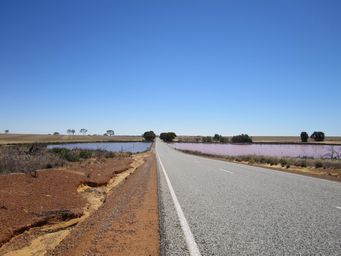
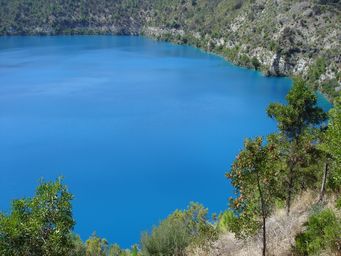
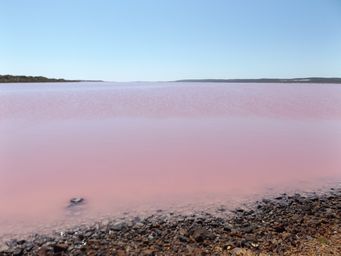
Hutt Lagoon at Port Gregory on the mid West coast is a pink salt lake due to the presence of the carotenoid-producing algae Dunaliella salina.
Dunaliella salina are a source of ß-carotene, a food-colouring agent and source of vitamin A. The lagoon contains the
world's largest microalgae production plant, a 250 hectare series of artificial ponds used to farm Dunaliella salina
Dunaliella
salina is harvested for beta-carotene as a dietary supplement and as a food colouring at Hutt Lagoon. This is also being researched
as a cancer treatment.
Additionally Hutt Lagoon provides a commercial supply of Artemia parthenogenetica brine
shrimp. Artemia is a specialty feed used by prawn and fish farmers and the aquarium fish trade
Murray Sunset National Park. The Pink Lakes: In spring, four of the park's lakes - Becking, Crosbie, Kenyon and Hardy - turn
a vivid pink. Above and at right, viewed early in September and already turning pink.
Lake Tyrrell, Sea Lake. Lake
Tyrrell, near the Mallee region town of Sea Lake, is well known for its clear reflections of the sky, while it is not
so well known that this lake also turns pink seasonally. Sea Lake campground has full services of power, toilets, showers and laundry
for $20 by honesty box, community managed.
What makes a lake pink?
It's the presence of a certain kind of algae that turns these lakes pink, reports TheWorldGeography.com.
Once the lake water reaches a higher salinity level than sea water and the temperature rises high enough, the reddish pigment beta
carotene begins to accumulate in the algae and, according to a Daily Mail story, the lake turns a brilliant pink colour.
A
pink lake is a lake that has a reddish or pink colour due to the presence of algae that produces carotenoids (organic pigments), such
as Dunaliella salina - a type of halophile green micro-algae especially found in sea salt fields. From The World Geography
What about other colours?
Lakes occur worldwide in a variety of colours, and one of the most well known in Australia is
at Mount Gambier. High on the hill in Mount Gambier is the famous Blue Lake, a volcanic crater lake which
is 204 metres deep at the deepest point. It also provides the water supply for the town. During summer, the brilliant
turquoise colour occurs. It is caused by calcite crystals coming out of solution in warmer water. The water
is a dull grey colour for much of the year.
Only in Australia?
Well known pink lakes outside of Australia are Lake Retba (Senegal), Salina de Torrevieja (Spain), Dusty Rose Lake (Canada), Masazirgol or Masazir Lake (Azerbaijan), Lake Magadi (Kenya), Great Salt Lake (Utah USA). There are also lakes in shades of rusty to blood red, and shades of greens and blues.
April 2016 updated December 2020
Pingrup Pink Lakes; these pink lakes are situated along the floor of a broad shallow valley that runs in a north-south direction between
Nyabing and Pingrup. They are part of the Chinocup Lake System, and lakes in differing shades of colours can be found in this
chain of lakes which stretch from Lake Grace to Pingrup on the course of an ancient river.
Similarly lakes to the north east of the town of Cranbrook via the Great Southern Highway can take on shades, including two which develop a rich shade of pink.
South of Perth, Lake Preston near Myalup, is a long shallow lake in a chain of coastal lakes, and its shallow highly saline water can heat in summer and gain a pinkish tinge from a combination of the algae Dunaliella salina with the bacteria Halobacteria.
Eight kilometres east of Three Springs is series of lakes which turn pink when the weather
warms them.
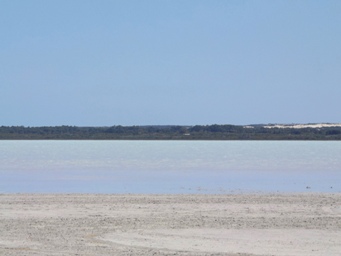
Victoria
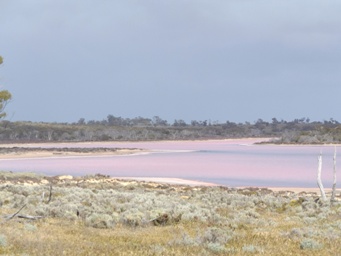
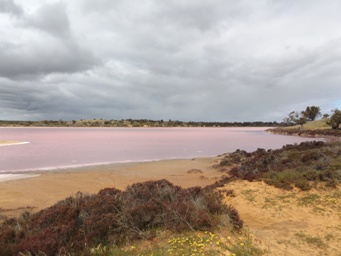
South Australia
There are Pink Salt Lakes along the Princes Highway with a viewing area for one of these twelve kilometres north of Meningie. Even Lake Albert, which links to Lake Alexandrina at the Narrung Peninsula, reportedly can appear pink at times.
On the Yorke Peninsula, there are pink lakes near Yorketown. This includes seasonal shades of pink and some can be orange.
Lake
Hart, within the Wimmera Rocket Range, is another mostly dry salt lake, however this too can have pink tones if there is water in
the summer. The southern end of Lake Hart can be viewed from the Stuart Highway.
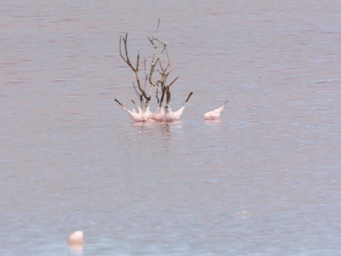
Mount Zero. Lakes in Melbourne at Westgate Park have been known to turn pink when evaporation in dry summers causes high salinity.
Loch Lel, Dimboola. Loch Lel Lake Reserve is a short way north west of Dimboola in the Victorian Wimmera region.
This is a large salt lake which turns pink in summer.
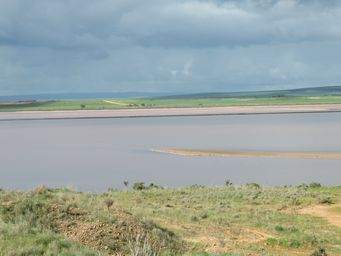
Lake McDonnell
Lake Macdonell, on the way to Cactus Beach, is a lake with high salinity and a pink hue from certain angles.
Located
13 km south of Penong is Lake MacDonnell is known to have the largest deposits of gypsum in Australia with estimated reserves in excess
of 500 million tonnes. The gypsum, which is now railed to Thevenard, has been mined since 1919. In the early days it was shipped from
a jetty at Port Le Hunte. The gypsum, which is used both as a fertiliser and in the building trade, has been laid down to a depth
of 4.8 metres. It is estimated that the gypsum, which is used for fertiliser and in the building trade, covers an area of 87 square
kilometres (8,700 ha) and that the yield is around 100,000 tonnes of salt which is harvested from the lake's brine pools.
Lake Eyre, which rarely fills, can appear pink i
n some seasons in years when it does have water.See more about Lake Eyre from our visit when the lake filled in 2019.